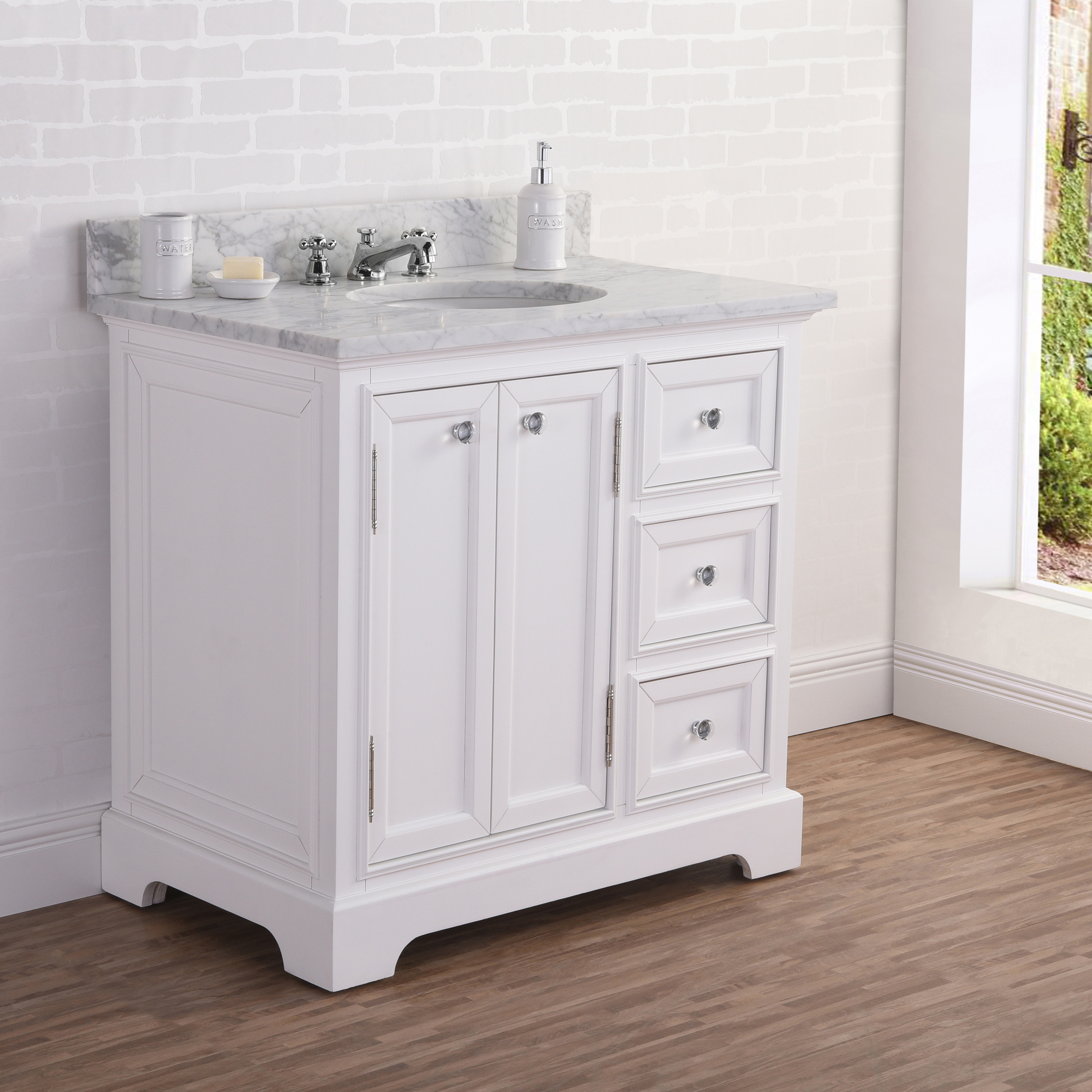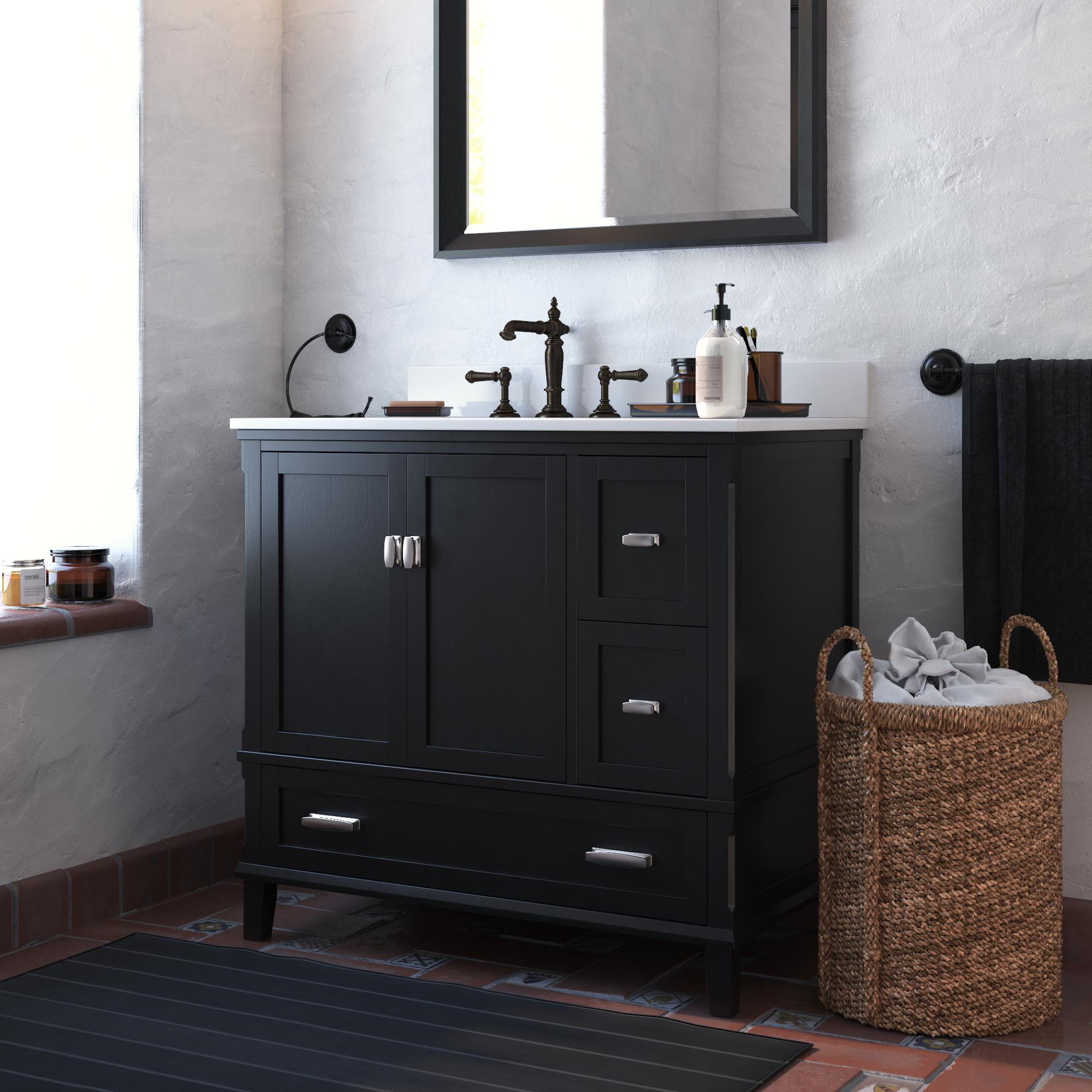Design and Style: 36 Gray Bathroom Vanity With Top

A 36-inch gray bathroom vanity with a top is a versatile piece that can complement a wide range of bathroom styles, from modern to traditional. The gray color provides a neutral backdrop that allows for various design choices, while the size is practical for smaller to medium-sized bathrooms.
Countertop Materials, 36 gray bathroom vanity with top
The choice of countertop material significantly impacts the overall aesthetic and functionality of the vanity. Here are some popular options:
- Granite: Known for its durability, natural beauty, and resistance to scratches and heat. Granite countertops come in a wide range of colors and patterns, making it easy to find a match for the gray vanity. However, granite can be porous and requires regular sealing to prevent stains.
- Quartz: An engineered stone that offers the look of natural stone with added durability and stain resistance. Quartz is non-porous and requires minimal maintenance. It comes in a variety of colors and patterns, including those that mimic the look of granite.
- Marble: Known for its elegance and unique veining patterns. Marble is a softer stone than granite or quartz and requires more maintenance to prevent scratches and stains.
- Laminate: A cost-effective option that offers a wide range of colors and patterns. Laminate countertops are durable and easy to clean but can be susceptible to scratches and heat damage.
Hardware Finishes
The hardware finish on the vanity, such as the cabinet knobs and pulls, can significantly impact the overall aesthetic.
- Brushed Nickel: A popular choice for modern and contemporary bathrooms. Brushed nickel provides a sleek and sophisticated look that complements a gray vanity.
- Oil-Rubbed Bronze: A warm and traditional finish that adds a touch of elegance to the vanity. Oil-rubbed bronze pairs well with gray and creates a sophisticated and timeless look.
- Polished Chrome: A classic and reflective finish that adds a touch of brightness and glamour to the bathroom. Polished chrome works well with a gray vanity, especially in modern or contemporary bathrooms.
Functionality and Storage

A 36-inch bathroom vanity offers ample space for storage, but the configuration of drawers and cabinets significantly impacts functionality. Optimizing storage is crucial, especially in smaller bathrooms, where every inch counts.
Drawer and Cabinet Configurations
Different drawer and cabinet configurations cater to specific needs and preferences. The following configurations are common in 36-inch vanities:
- Single Drawer with Large Cabinets: This configuration features a single drawer at the top, often shallow, and large cabinets below. This layout provides ample space for storing larger items, such as towels, linens, and toiletries, while the drawer is ideal for smaller items like makeup and brushes.
- Multiple Drawers with Smaller Cabinets: This configuration offers multiple drawers of varying sizes, with smaller cabinets below. This provides a balance of storage options, with drawers for smaller items and cabinets for larger items.
- All Drawer Configuration: This layout features multiple drawers of varying sizes, maximizing storage space for smaller items. This is ideal for bathrooms where space is limited and organization is key.
Benefits of Soft-Close Drawers, Pull-Out Shelves, and Built-in Organizers
Incorporating features like soft-close drawers, pull-out shelves, and built-in organizers enhances functionality and storage efficiency:
- Soft-Close Drawers: These drawers close silently and smoothly, preventing slamming and damage to the vanity. They also provide a more luxurious and refined feel to the bathroom.
- Pull-Out Shelves: Pull-out shelves maximize storage space by making items easily accessible. They are ideal for storing smaller items like toiletries, makeup, and hair styling tools.
- Built-in Organizers: Built-in organizers, such as dividers and trays, help to keep items separated and organized within drawers and cabinets. This makes it easier to find what you need and keeps everything tidy.
Designing a Layout for a 36-Inch Vanity
A well-designed 36-inch vanity layout prioritizes functionality and caters to the specific needs of the bathroom:
Master Bathroom
A master bathroom vanity should prioritize ample storage for a variety of items, including toiletries, hair styling tools, and personal care products. A layout with multiple drawers of varying sizes, along with large cabinets for storing towels and linens, would be ideal. Consider incorporating soft-close drawers and pull-out shelves for maximum convenience and organization.
Guest Bathroom
A guest bathroom vanity should provide adequate storage for toiletries and towels. A single drawer with large cabinets below is a practical configuration. This layout provides ample space for storing towels and linens, while the drawer can be used for storing toiletries. Consider incorporating pull-out shelves for maximizing storage space.
Installation and Maintenance

Installing a 36-inch gray bathroom vanity with a top involves several steps, requiring specific tools and adherence to safety precautions. Proper maintenance ensures the longevity and functionality of the vanity.
Installation Process
Installing a bathroom vanity requires careful planning and execution to ensure a secure and functional setup.
- Preparation: Before starting the installation, gather the necessary tools, including a level, tape measure, drill, screwdriver, wrench, and plumbing tools. Ensure the area is clear and protected from damage. Turn off the water supply to the bathroom and disconnect the existing plumbing fixtures.
- Installing the Vanity Base: Position the vanity base against the wall, ensuring it is level and plumb. Mark the wall for the mounting points and drill pilot holes. Secure the vanity base to the wall using appropriate screws or anchors.
- Installing the Countertop: Carefully place the countertop on the vanity base, ensuring it is aligned and level. Secure the countertop to the base using appropriate fasteners. Consider using silicone sealant to prevent water leaks between the countertop and the vanity base.
- Plumbing Connections: Connect the vanity’s plumbing fixtures to the water supply lines, ensuring all connections are tight and leak-free. Use Teflon tape on the threaded connections to prevent leaks.
- Testing and Finishing: Turn the water supply back on and test the faucets and drains for leaks. Install the vanity’s hardware, including the handles, knobs, and mirror. Clean the vanity and countertop thoroughly to remove any debris or residue.
Maintenance Checklist
Regular maintenance ensures the vanity remains in optimal condition and prevents potential issues.
- Cleaning: Clean the vanity and countertop regularly using a mild cleaner and a soft cloth. Avoid harsh chemicals or abrasive cleaners that could damage the finish. Wipe up spills immediately to prevent staining.
- Ventilation: Ensure proper ventilation in the bathroom to prevent moisture buildup. Use a bathroom fan or open a window during and after showering to remove excess humidity.
- Water Damage Prevention: Inspect the vanity and countertop for signs of water damage, such as leaks, cracks, or warping. Address any issues promptly to prevent further damage. Regularly check the caulking around the countertop and vanity base, and reapply if necessary.
Common Issues and Solutions
Bathroom vanities can experience various issues over time.
- Leaks: Leaks can occur due to loose connections, worn-out seals, or damaged plumbing fixtures. Inspect the plumbing connections, replace worn-out seals, or repair damaged fixtures as needed.
- Staining: Staining can occur due to spills or water damage. Clean stains promptly using a mild cleaner or a stain remover designed for the countertop material.
- Hardware Issues: Hardware, such as handles and knobs, can become loose or damaged over time. Tighten loose screws or replace damaged hardware as needed.
- Cabinet Door or Drawer Problems: Cabinet doors or drawers may become misaligned or difficult to open or close. Adjust the hinges or drawer slides as needed.
